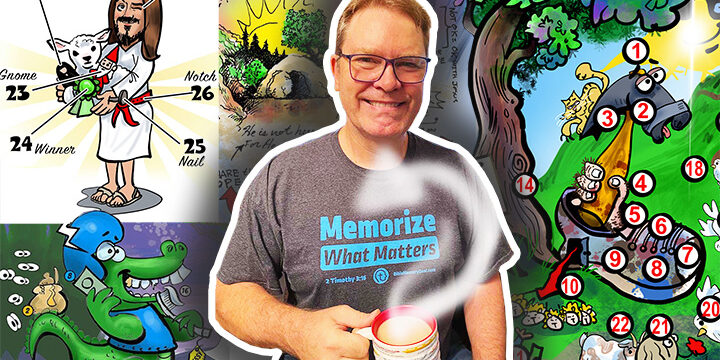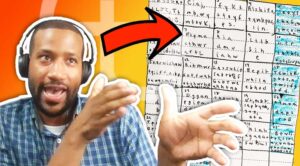How does a caricature artist like Jody Brownd create imaginative, virtual memory palaces for Scripture memory? Watch as Jody explains his illustrations, his approach to Scripture memory and where he gets his inspiration.
Or you can listen to the Memorize What Matters podcast on your favorite player:
Listen to “How a Caricature Artist Memorizes the Bible (w/ Jody Brownd)” on Spreaker.Here are a couple of the resources mentioned in the interview:
- Jody’s Website: https://www.bamsystem.org/
- On YouTube: Jody’s YouTube channel
Below is a transcript of the conversation Jody had with Josh on the podcast:
Jody Brownd Interview Transcript:
Jody: I started doing caricatures at Astro World in ’84 and in ’85. It was a summer job while I was in art school.
Josh: Nice
Jody: Ever since, and it was like, that’s when I fell in love with cartooning and caricatures in general, so now I’ve been doing it for 37 years. And really what inspired me was Monet and Degas and van Gogh. I needed Monet to buy the gas to make my van go.
(rimshot crashing)
(Josh laughing)
Josh: Well, I’ve got some of your illustrations but before we get to that, I wanted to ask you, has Bible memory been something that you’ve done for a long time? Have you been a believer since you were young or did it happen later in life? How does that story pan out for you?
Jody: Well, long story short, my dad’s a physicist with NASA, and he did orbital dynamics and keeping track of the shuttle and satellites and such. When I was about 19 years old, he got saved. And he said, “Jody,” he says, “I don’t see how man could have ever written this book, the Bible.” He says, “I’m gonna believe it until I see otherwise.” Spoken like a scientist. And now he’s really into creation research, and smartest man I know. That’s how I got saved, was he changed my mind about whether the Bible’s true or not.
Josh: Wow
Jody: And I started memorizing Scripture early on with the Book of Romans. I made it all the way up to chapter 7 using rote memory because that’s all I knew, and I felt like my brain was just breaking down. (chuckling) It’s like, I can’t get past seven. I just couldn’t, the review process. And so with this community, I have been inspired to start back with Romans, but I’m using the memory palace now, so, yeah.
Josh: Well, I feel like you, there’s a term in business that I really like that’s called an unfair advantage. So when I’m doing business, I’m trying to find what my unfair advantage is and then exploit them, in a good way, right? It’s not anything negative. It’s very much taking, I think that maybe a better way or a more spiritual way of saying it is recognizing where God has given you gifts and talents and then using that, right? And I think the unfair advantage you seem to have, I don’t even say seem, you do have, is the ability to be able to create memory palaces out of thin air.
And so for most people, myself included, a mind palace or memory palace, or whatever you wanna call it, is usually built out of a place that physically exists in the world that I have been to and walked around. After you do this for a while, but for you, and this is something that I’ve been asked a lot, it’s like, is it possible to create what people sometimes call virtual mind palaces? And I think that’s kind of what you do. Can you explain a little bit about your drawing, or, excuse me, your illustrations, your drawings, or whatever you wanna call it, and how you’re doing that and using it to memorize portions of Scripture?
Jody: Right. Well, when I learned about the mind palace from Ron White, by the way. In fact, me and Ron White were like this. This is me way over here.
Josh: (laughing) Nice.
Jody: But I bought his audio book, and I was going through kind of sad time where I was like, “What am I gonna do? What am I doing? What am I gonna do? I need to make more money. A caricature artist, I don’t make enough.” And so I thought, I’m searching what kinda audio books to listen to, and I ran across his. I listened to it, I’m like, “You know what? I could go to school now with these memory techniques and just blow through school and get a really good job.” And I thought, “Well, let me memorize Scriptures instead,” and then I started memorizing Scripture, and it’s like, “For the word of God is quick and powerful, and sharper than any two-edged sword, piercing even to the dividing asunder of soul and spirit, and of the joints and marrow, and is a discerner of the thoughts and intents of the heart.”
And I thought, “I think I need to memorize Scripture. I think that’s what my problem is. I need God.” And I’m already a Christian, but when I started memorizing Scripture, just changed everything. I start memorizing Scripture. I used the furniture. Took my house, I started going through each room and doing furniture. I thought, “I need to have something for each book of the Bible,” So I did a little math. I’m not real good at math. In fact, I had a math book, but I had to get rid of it. It had too many problems.
So I took nine items in the first room, and then I took 10 items and 10 items, and 10 items, and 10 items, and then 7 in the last. So that gave me 66 pieces of furniture. I was able to put a book on each piece of furniture. But the problem was, how am I gonna build a memory for the Book of Genesis for the front door? And so I thought, “Well, I don’t have to use everything about the front door to memorize the 50 chapters of Genesis.” And so I thought, “Well, I can use anything I want,” and I realized that there’s 50 states in America. It’s like, “Oh, well, the states can be my memory palace.” So there you go. So I took the 50 states, numbered them as if I was driving through America. So I started at the top right in Maine and just worked all the way down the East Coast and all the way across. My goal is not to memorize word for word, but the structure. So I want to know what’s in Texas per se. Texas is 21. It’s the 21. And I’ve given them these numbers. There’s no other reason for them to be those numbers except it seems like a logical flow for me to go through.
So 21 is chapter 21 of Genesis. And what happens in Texas? That’s where Isaac is born to Abraham. So Isaac is a, is a native Texan, and that’s how I remember where certain things happen. So let’s do South Carolina. That’s the 15th chapter. That’s where it says, “And he believed in the Lord, and he counted it to him for righteousness.” So that’s in South Carolina. So little things like that helped me to remember, and because I have the palace set up, when somebody’s preaching or on something in the book of Genesis, I’m like, “Okay, what chapter is it? What state is it?” I can keep on building on it instead of just memorizing the whole thing at one time, which would be okay, but I’ve got it. I’ve got it, and I’ll have it for the rest of my life.
Josh: Exactly, yeah, I mean, I did something very similar for the Gospel of John, and what I refer to it as is structural memory. So you’re obviously not going word for word, but you’re memorizing the structure. And I think there’s value.
Jody: That was a great video, by the way, yeah.
Josh: Oh, thanks, Jody. I appreciate that. And I do think there’s value in being able to, even if you haven’t memorized Genesis word for word, but if I were to say to you, “Hey, Jody, where’s that story about Isaac?” and you’re to say, “Oh, I can find that. That’s in Genesis chapter 17,” or whatever you were saying, I think that is incredibly valuable. I love that you’ve been able to do that. And obviously this would work maybe for Americans who have a sense of geography, and then maybe for those who don’t know all 50 states, that might just drive them entirely nuts. But let me show you.
Jody: I did not know all 50 states when I started.
Josh: Really? Okay.
Jody: I thought, “You know what? It would be worth learning them.” So I meet people from all over the United States, and it’s always nice when they say, “I’m from Michigan,” and I visualize where they’re from. “Oh, it’s cold up there, isn’t it?” instead of saying, “Is it hot there too?” (chuckling)
Josh: Exactly.
Jody: I know where they’re from, and so it’s just good. It’s good to know where all the states are.
Josh: Yeah And I’m sure somebody could do this with the European Union or different parts of the world. It doesn’t just have to be the United States. But let me bring up another one for you That you shared within our group. This is for Lamentations 3:22-27. And this is where you’re doing a little more, I guess, word for word as opposed to a structural memory. Can you kinda walk us through what you’re doing as you drew out this illustration and why?
Jody: Sure, there are some Scriptures that I feel like are really worth learning word for word, and this was one of ’em. It usually starts out with one verse, and then I’m curious to what the context is. It ended up being that I thought 22 through 27 was a really good group. So what I did was, of course, my memory palace for the Book of Lamentations is about a little lamb that goes on a little journey, so I made a map of the different places he ends up being. And in chapter three, Jesus is holding a lamb, so that’s what the picture is. And then I add items from the major system. So you’ve got 22 as a nun. Does that look like a nun? That’s a nun, if anybody was wondering
Josh: I can see it, yeah.
Jody: What that was, yeah. So a nun, and then 23 is a gnome, 24 is winner,25 is a nail, 26 is notch, And 27 is wink. Now when I memorize these verses, I try to imagine the picture that goes with what the verses say. For example, 22 is a nun, And so now I’ve got a link. What would a nun have to do with the verse? And the verse says, “It is of the Lord’s mercies that we are not consumed because his compassions fail not.”So maybe there’s a nun, and she’s hitting a little boy on the knuckles with a ruler. I hope that didn’t get me in trouble
(Jody and Josh chuckling)
but the Lord’s not like that. His compassions fail not. And then 23 is a gnome, so I’m like, “Okay, well, how can I relate a gnome to this next verse?” And so I imagine if I was to get up in the morning, now this is kinda freaky, but when you make your pictures a little bit crazy, it helps you to remember. So I come into the kitchen, and there’s a gnome in the window sill. And every time I get up in the morning, the gnome is somewhere else. It’s new every morning, just something. So, “It is of the Lord’s mercies that we are not consumed because his compassions fail not. They are new every morning: great is thy faithfulness.” So when I’m trying to memorize the verse, I keep the picture in my head as I repeat the verse over and over and over.
Josh: I wanna ask you a couple practical questions here, Jody, as I pull something up, out. Okay, so I’m showing something on screen. It’s just a few of your drawings from 1 John. So a couple questions. How long does each one of these drawings take you, and then how many are color versus black and white? Which you can see we’ve got both here.
Jody: Right. All right, the reason they’re in black and white, well, I like to have it in black and white, and then I can color it. So I can always have my black and white version and then just color whenever I want to. But the idea for 1 John, having all these drawings in black and white is somebody could print these off and color it, color them themselves.
Josh: Oh, wow.
Jody: And that would help them to remember what the verses say. It’s hard to convince people that they can do the memory palace because they say, “But I’m not an artist. I can’t draw all those pictures.” It’s like, you don’t have to be able to draw everything like I do. You just make a little stick men, draw notes. It’s what you imagine rather than what you’re able to draw. Also, another thing about the major system, where you’ve got, you know that you’ve got 1, 2, 3, 4, 5, 6, 7. You’ve got these verses. And so when you get to seven, and it’s like, “I can’t remember what the picture was.” Well, it could have been a key, or it could have been a cow, or it could have been awake, or it could have been a koi. Could have been one of these things, and it’s like multiple choice.
Josh: I think that that is a great point and one worth ending on. First of all, for anybody who’s watching or listening to this, and you don’t even know what we’re talking about with the major system, I do explain The Major System for memory here. Essentially, we’re just taking numbers, turning them into sounds, and then putting those together to make words, and that helps in memorizing the numbers or the verse numbers. But you don’t have to use numbers when you’re doing the memory palace if you don’t want to. There are so many different ways to do this, and I think that this is a great example, where for Jody, you wanna use different images for every single time that you use the number 12. For me, I wanna use the same image for number 12, which for me is eggs. Easy, like a dozen eggs, 12, like that, so anytime I’m looking for 12, I’m looking for eggs.
And I love the fact that God has designed our brains to operate in different ways, such that for you, that works really well, and for me, keeping it the same image works really well, and that’s great. That’s okay. So an encouragement to all of you who are listening or watching, this is just, hey, find the method that really clicks with your brain and then run with that. If you’re an illustrator, illustrate. If you just like rote memory, then keep going with rote memory. That’s okay. Just enjoy the process.
Jody: Yeah, I will say this about the way I do things. I’m like, “Everybody should do it exactly how I do it.” And getting into the community, one of the things, it’s like, no, that’s not what’s important. The important thing is, is that you’re memorizing Scripture, however it works for you. Ron White, I loved the memory interview with Ron White. He said, “You find what works for you and do that.” I think that was really wise, wise advice.
Josh: Well, we’re all on our own journey, and it really is exciting to be able to be encouraged and inspired, like you’re saying, by a lot of these people. Well, Jody, as we close up here, can you share, where would people find more of your illustrations, find out more about you? Do you have a website that you’d like to share?
Jody: Yeah, it’s called bamsystem.org. And BAM, I guess I should tell you what the B-A-M stands for, right? Bible Allegory Memory System because you’re making up pictures that don’t have anything to do with the Scriptures and relating them in order to memorize them. So Bible Allegory Memory System.
More Bible Memory Resources
Are you interested to memorize more of God’s Word? Check out the various resources we have available on Bible Memory Goal:
- Not sure where to start? Learn where to start with Bible memory here!
- Want to join a community? We have a great Bible memory community here!
- Want to listen to more interviews? We have amazing Scripture memory interviews here!



Leave a Reply